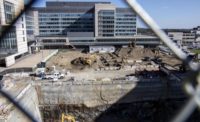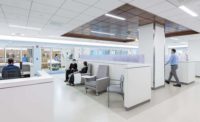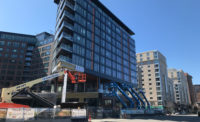UMass Boston has embarked on a $150-million makeover of its big brick-and-concrete campus overlooking Dorchester Bay.
Construction manager Gilbane Building Co. is overseeing the project, which involves demolishing and removing the university’s crumbling concrete quad and an aging science building, replacing it with green space, walking paths, hundreds of trees and a more traditional campus feel.
The new and improved campus, when it debuts in 2022, will mark a striking change from UMass Boston’s original design. Built in the early 1970s, the university’s campus long featured a series of hulking brick-and-concrete buildings surrounding a concrete quad, a design derided by critics for its enclosed fortress-like feel.
The effort is also just the latest in a series of projects that has seen a new look emerge for the campus, with the still mostly commuter school building its first dorm three years ago, as well as a new science center and a new student center.
Demolition work began last year and has been gathering momentum over the winter and early spring as crews finish taking down the university’s 70s-era science complex.
The jobsite has taken over a significant chunk of the campus: 27 out of a total 120 acres.
“This is a huge, transformational project for the campus,” says Mike Kearns, the school’s associate vice chancellor for facilities management.
Plans call for building a 25-ft, gently rising, grassy slope—dubbed the quad—crisscrossed with meandering pathways, leading from a new 300-car parking lot. At the top will be a new, tree lined plaza, or concourse, between the buildings on campus.
The slope, in turn, was “purposely measured to be ADA accessible,” Kearns says.
Underworld Ties
The original construction was marred by a corruption scandal that sent two state senators to prison and resulted in a series of state reforms in how public construction contracts are bid.
The campus’ underground parking garage was constructed with inferior concrete and closed a decade and a half ago as sections of crumbling concrete gave way. The corrosive salt air blowing in from Dorchester Bay also did not help, experts say.
Crews are now working in the old garage space located underneath three major campus buildings to reinforce their foundations, says Kevin Cooke, a senior project executive at Gilbane.
That involves cutting away the damaged concrete columns and beams that have eroded, exposing the rebar and replacing and fixing it.
Structural steel has been brought in to help seismically brace the foundation of the buildings as well, according to Cooke.
The old parking spaces under the buildings will no longer be used; UMass Boston opened a new free-standing, 1,400-space garage in 2018 to replace the underground parking.
Fulfilling Project
Dealing with defective concrete has not been the only challenge though.
The campus sits atop a capped landfill, with Columbia Point used for decades as a dump before the waterfront acreage was converted into Boston’s only public university.
The peculiar nature of the site on which UMass Boston was built has required special efforts to prevent buildings around the campus from settling by as much as two to three ft after demolition and removal of the concrete quad, Gilbane’s Cooke said.
To prevent settling, two 30-ft-wide concrete tunnels will be built to create a structural void adjacent to the existing buildings. These structures will relieve downward pressure from the soils being placed above and adjacent to the buildings to shape the perimeter of the new Quad.
“It’s all urban fill,” Cooke—who grew up in neighboring Quincy and could see the dump in operation across the bay—said of the site’s composition. “They had a processing plant there for a while. Every one of those buildings has a methane recovery system.”
Underneath the structural voids and the structural soils being placed over them, 100 different pilings will provide additional support for the fill and other materials used to create the plaza on the upper level, with crews now gearing up to do this job.
Another painstaking job involves the waterproofing tie-ins between the new plaza and the campus’ old brick buildings.
This has to be done one section at a time, with crews having to remove the “bottom courses of brick” in “a phased, hopscotch approach to maintain the integrity of the existing structures,” Cooke says.
“Due to the nature of the tie-ins, each location needs to be abated individually in sections,” Cooke said in an email. “This is a slow process, as one could imagine.”
Bunker Busting
To date, demolition contractor Select Demo Services has taken down the old quad and the parking underneath, a pool building and more than 60% of the school’s old science building.
Demolition debris isn’t going to waste. Crews are crushing and removing concrete debris, with plans to recycle tens of thousands of cubic meters of old material into fill that will be used as a foundation for core of the revamped campus.
That includes 30,000 cu yd of contaminated soil left over from other projects, carefully layered to contain it, as well as 90,000 yd of crushed concrete from the demolition.
“We are crushing the concrete and brick,” Kearns says, “and we are putting most if it—if not all of it—back into the hole.”






Post a comment to this article
Report Abusive Comment